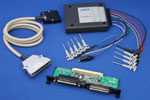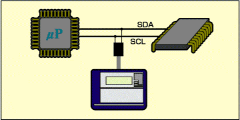OP-SB5G TTL/I2C Expansion Kit
[ Discontinued ]
The successor is OP-SB5GL.
The successor is OP-SB5GL.

Expansion board with probe pod for monitoring I2C and clock-synchronized TTL level communications. Ideal for onboard probing connections for monitoring communications between LSIs.
Outline
 OP-SB5G is the interface expansion
kit equipped with two kinds of the ports to measure communication:
RS-232C (V.24) and TTL/C-MOS signal level. In TTL/C-MOS
measurement, the communication line of TTL/C-MOS level
between LSI and interface IC, power supply system 3V or
5V, is connected with the IC clip. Then, communication
state can be monitored, and also the response can be checked
outputting data.
OP-SB5G is the interface expansion
kit equipped with two kinds of the ports to measure communication:
RS-232C (V.24) and TTL/C-MOS signal level. In TTL/C-MOS
measurement, the communication line of TTL/C-MOS level
between LSI and interface IC, power supply system 3V or
5V, is connected with the IC clip. Then, communication
state can be monitored, and also the response can be checked
outputting data. Moreover, communication state of two-wires synchronized I2C can be monitored. Also, your analyzer operates as slave or master, and you can input/output data. In addition, you can use the burst measurement mode, which can capture all data.
Operating Instructions
 After inserting the expansion
board into an analyzer (LE-3500/LE-2500),
the communications line you want to measure is connected
using the included probe pod. Since nine kinds of the
signal lines can be tested, you can measure various communications:
SD, RD, RS, CS, SD_CLK, RD_CLK, external input, trigger
input and trigger output. Moreover, you can set the polarity
of data and the clock you wish to capture.
After inserting the expansion
board into an analyzer (LE-3500/LE-2500),
the communications line you want to measure is connected
using the included probe pod. Since nine kinds of the
signal lines can be tested, you can measure various communications:
SD, RD, RS, CS, SD_CLK, RD_CLK, external input, trigger
input and trigger output. Moreover, you can set the polarity
of data and the clock you wish to capture.
Monitoring
[ Example of Clock
Synchrounaous Communication ]

In the normal mode (USART),
you can make full use of the functions of an analyzer
such as the trigger function. Also, by setting the BURST
mode on the analyzer, you can measure communication system
(clock synchronous communication) which supplies the clock
at the time of only transmitting data. That makes it possible
to monitor communication that the old protocol analyzers
cannot measure. In addition, by setting the I2C
mode, you can test the I2C serial communications
including the start sequence and stop sequence. Since
the translation display is available in I2C,
you can efficiently analyze the sequences of Read and
Write.
Synchrounaous Communication ]

<I2C
Measuring Result Screen> |
<I2C
Translation Screen> |
Logic Analyzer
 By using the
logic analyzer function, you can check the data logic
and the timing for capturing the clock in the waveform.
Especially, the serial interface between LSI often can
be a problem regarding the phase difference and the delay
of the clock and data. In this case, the logic analyzer
function enables you to analyze by bit timing.
By using the
logic analyzer function, you can check the data logic
and the timing for capturing the clock in the waveform.
Especially, the serial interface between LSI often can
be a problem regarding the phase difference and the delay
of the clock and data. In this case, the logic analyzer
function enables you to analyze by bit timing.
Simulation / Bert
Excepting the BURST mode, using the simulation function enables you to vastly enhance the efficiency of the development and the trouble analysis. In the I2C mode, you can simulate in both the master and the slave. Also, since the bit error rate test (BERT) is available in the normal mode (USART), you can easily test the transmission feature of the device, etc.Specification
| Interface | RS-232C, TTL, I2C |
|---|---|
| Probe Signal | SD (SDA), RD, RS, CS, EXIN, SDCLK (SCL), RDCLK, Trigger IN, Trigger OUT [Lead Length: 170mm] |
| Protocol | I2C, Clock SYNK (*1) |
| Function | Monitor / Simulation /BERT (*2) |
| Speed (I2C Test) | 100Kbps, 400Kbps, 1Mbps |
| Input Impedance | 100K Ohm, (0<=Vin<=5V) Vin max. -25V to +25V |
| Input Level Threshold | High: Min.2.2V, Low: MAX.0.9V |
| Output Level Voltage | High: 3.0V, 4.5V, without pull-up (*3), Low: Max.0.5V |
| Composition | Dedicated expansion board (SB-20N), Relay cable, Probe pod |
(*2) I2C BERT testing not supported.
(*3) Set from analyzers.